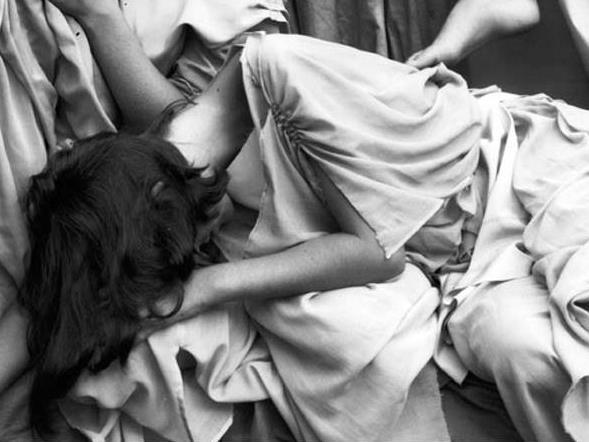Shadow Land is a retrospective of Australian artist Anne Ferran’s work in photography, textiles, installation and text over 30 years, on show as part of the Perth International Arts Festival. It is the largest collection of her work in an Australia exhibition and her first exhibition in WA.
The shadows and curves where things are not quite seen are a significant feature of this exhibition. For me, standout pieces include are the untitled series of eight works from ‘Carnal Knowledge’ (39x55xm, 1984). These are based on classical staged tableaux (as are the ‘Scenes on the death of nature’ works) and the gelatin silver photos have an external finish that results in a type of crackling of the images. It reads almost as anguish on the faces of the subjects in some cases, even though the first text piece explains that the inspiration for these works is Jupiter’s comment to Juno that women get more pleasure out of love than men, and that we determine knowledge through a type of blindness. The women’s faces are vague, sometimes turned away – is it hidden desire from themselves or not partaking of the male desiring gaze? In the last piece, it feels like the woman portrayed has almost become statue-like. Whereas the five ‘Scenes on the death of nature’ gelatin silver photographic works feel much more contrived – perhaps because of their grandness (these works are up to 173x114cm) – or the repetition and uniformity of the girls/women in these images. Draped in rough cotton sheets, either looking out of frame or languorously entwined with another, they seem strangely empty.
Ferran’s ‘I am the rehearsal master’ (91×107, 1989) again uses the slight deterioration effect on the gelatin silver photograph. In the gaps where the image is slightly eaten away, the posed image of the woman in what could be sexual ecstasy (lying on her back with legs raised and entwined and hair thrown akimbo and writhing arms) eventually becomes grainy like the old fashioned flip-books or kineographs – but again strangely compelling.
Another set of works that I find appealing are the archived images of female psychiatric residents from the mid-1940s’ ‘Insula’ and ‘1-38’ (2003), which are then manipulated by Ferran. Following the 38 works around the three walls, we see a series of framed mid torsos; images that talk and interact without the need for faces. We see incredibly expressive hands, sagging breasts, buttoned cardigans, also someone pulling someone’s arm, or, on one or two occasions, a face turned away.
I also enjoy the quasi-x-rayed work of museum artefacts which include christening gowns, bonnets, textile strips (possibly menstrual belts), pincushions, handerkerchiefs, girdles and other items from women’s wardrobes. They are produced using a non-camera form of photography where objects are placed into photographic paper and exposed to light resulting in the negative image. Presented in the dimly lit gallery, in either black framed boxes or in the pull-out museum drawers, these suspended pieces have a chilling ghostly literalness that is made more solid by their framing. What was once a filled-out christening gown shifts into a floating white empty object with an added poignancy lent by the outline of a museum tag.
Ferran’s ‘Rydalmere’ set of four works (C Type photographs, 141x108cm, 1997) are probably the most recognisable of her works with five – six empty women’s headpieces (soft caps) photographed on a tarpaulin covered table in a barn-like structure near an empty fireplace. When photographed from behind, you can almost see the structure of the women’s heads, but the incongruity of these caps sitting (almost full of body) on top a table is a discomfiting experience.
There are other works too, including, ‘In the ground, on the air’, which is part of a series of works where Ferran has explored sites where female convicts from the 1800s arrived at workhouses or factories in NSW and Tasmania, and two video works ‘Canal’ (2009) and ‘Body of Water’ (2011) which weave in and out of waterways, showing urban growth or decay and encroaching manufacturing sites. They are described as ‘waterways disappearing due to urban expansion’, again pointing to gaps. Overall Ferran’s body of work is designed to be contemplated and absorbed slowly, with a good understanding of who she is photographing to fully enhance the meaning of her project. But this is important work eliciting stories from people who are not often seen.
Rating: 3 ½ out of 5 stars
Shadow Land
By Anne Ferran
Lawrence Wilson Art Gallery, Crawley
Perth International Arts Festival
www.perthfestival.com.au
8 February – 19 April





